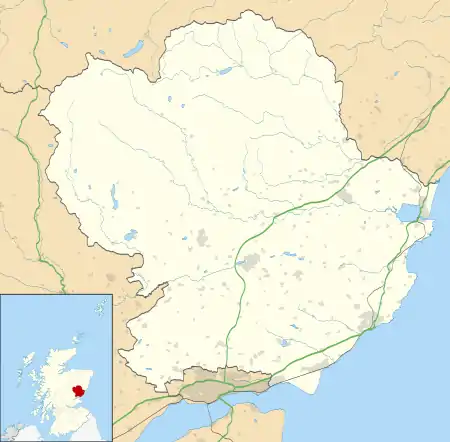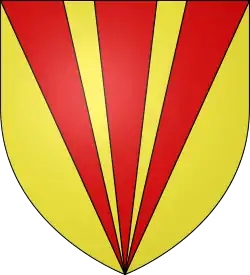Brechin
Brechin (/ˈbriːxɪn/; Scottish Gaelic: Breichinn) is a town and former Royal burgh in Angus, Scotland. Traditionally Brechin was described as a city because of its cathedral and its status as the seat of a pre-Reformation Roman Catholic diocese (which continues today as an episcopal seat of the Scottish Episcopal Church), but that status has not been officially recognised in the modern era.[3][4] Nevertheless, the designation is often used, with examples being the City of Brechin and District Community Council, City of Brechin and Area Partnership, City of Brechin Civic Trust and Brechin City Football Club.[5]
Brechin
| |
|---|---|
 Brechin Cathedral | |
 Brechin Location within Angus | |
| Population | 7,400 (mid-2016 est.)[2] |
| Demonym | Brechiner |
| OS grid reference | NO600600 |
| Council area | |
| Lieutenancy area | |
| Country | Scotland |
| Sovereign state | United Kingdom |
| Post town | BRECHIN |
| Postcode district | DD9 |
| Dialling code | 01356 |
| Police | Scotland |
| Fire | Scottish |
| Ambulance | Scottish |
| UK Parliament | |
| Scottish Parliament | |
History
In the centre of Brechin is a small museum in the former town house, and an award-winning tourist attraction, the Caledonian Railway.[6][7] Along with the cathedral and round tower, part of the chapel of Brechin's Maison Dieu or hospital survives from the Middle Ages; the Maison Dieu was founded before 1267 by William de Brechin.[8] The Maison Dieu chapel is in the care of Historic Environment Scotland.[9] The Bank Street drill hall was completed in 1879.[10]
The Guildry Incorporation of Brechin was formed in 1629 by merchants and traders in the Burgh and in 1666 obtained recognition of its rights under Decree of the Convention of Burghs.[11] The Guildry's historic purposes have been assumed by local government and its current functions are social and civic.
Religion
Brechin Cathedral
The town is well known for its cathedral, with eleventh century round tower (Historic Environment Scotland), one of only two of these Irish-style monuments surviving in Scotland (the other is at Abernethy, Perthshire). The tower was originally free-standing, but is now incorporated in the framework of the cathedral.
The cathedral has been much altered, but still contains medieval work of the 13th and 14th centuries, notably a handsome western tower and processional door.
Scottish Episcopal Church
In 1695, following the Glorious Revolution, the town's Episcopalians were driven out of Brechin Cathedral which remained under the control of the Church of Scotland. A meeting house was set up in the High Street with a chapel being built in 1743. Following the Jacobite rising of 1745, the chapel's seats and books were destroyed by government forces and the chapel was taken over by a qualified congregation. A new Episcopalian Church, St Andrews Church was built in 1809 and consecrated in June 1811. This was replaced by a new building in 1888. St Andrews Church is part of the Diocese of Brechin and its archives are held by the University of Dundee.[12]
Governance
Brechin is represented within Angus Council by the Brechin & Edzell ward, from which three councillors are elected. The members elected from this ward are, as of 2019; Kenny Braes (Scottish National Party), Bob Myles (Independent) and Gavin Nicol (Conservative & Unionist).[13]
Education
Education in Brechin is managed by the Education Department of Angus Council. There is one secondary school in the area; Brechin High School and four feeder primary schools; Andover Primary school, Edzell Primary School, Maisondieu Primary School and Stracathro Primary School.[14]
Sport
Football
Brechin City Football Club play Scottish League football and are currently placed in Scottish League 2. Its ground is called Glebe Park and is situated off Trinity Road. Glebe Park is the only senior football ground in Europe which has a hedge along one of its perimeters. Brechin is also home to the junior football club Brechin Victoria who play at Victoria Park.
Notable people
- Sir David de Brechin (d.1320), Lord of Brechin
- Robert Watson-Watt, radar pioneer, born in Brechin
- Joseph Fairweather Lamb, academic and former Chandos Chair of Physiology at the University of St Andrews
- Dame Anne Begg, Former Member of Parliament for Aberdeen South.
- Brian Keany, artist.
- Robin Orr composer.
- David Myles, former MP for Banffshire and public servant.
Gallery
 Door to Brechin Round Tower
Door to Brechin Round Tower Coat of arms of Brechin, based on the arms of Henry, Lord of Brechin
Coat of arms of Brechin, based on the arms of Henry, Lord of Brechin
See also
- Battle of Brechin
- List of places in Angus
- Brechin Castle, seat of the Earls of Dalhousie since the late 20th century
- Brechin railway station
References
- "Ainmean-Àite na h-Alba - Gaelic Place-Names of Scotland". Gaelicplacenames.org. Archived from the original on 28 October 2012. Retrieved 5 March 2014.
- "Mid-2016 Population Estimates for Settlements and Localities in Scotland". National Records of Scotland. 12 March 2018. Retrieved 30 December 2020.
- Beckett, J V, City status in the British Isles, 1830–2002, Historical urban studies. Aldershot 2005
- "UK Cities". Department for Constitutional Affairs. 2002. Retrieved 15 August 2008.
- City of Brechin & District Area Partnership. "Members". Archived from the original on 5 January 2009. Retrieved 15 August 2008.
- "Welcome to The Friends of Brechin Town House Museum Website - Home". brechintownhouse.org.uk. Retrieved 1 January 2019.
- "Welcome to the Caledonian Railway | Caledonian Railway". caledonianrailway.com. Retrieved 1 January 2019.
- "Brechin, Maisondieu Lane, Maisondieu Chapel | Canmore". canmore.org.uk. Retrieved 1 January 2019.
- "Maison Dieu Chapel". www.historicenvironment.scot. Retrieved 1 January 2019.
- "Angus Classic Interiors, (former Drill Hall), 13 Bank Street, Brechin". British listed buildings. Retrieved 23 June 2017.
- "The Guildry of Brechin | Court of Deans of Guild of Scotland". www.deansofguildscotland.co.uk. Retrieved 1 January 2019.
- "BrMS 16 Records of St Andrew's Episcopal Church, Brechin". Archive Services Online Catalogue. University of Dundee. Retrieved 13 July 2018.
- Angus Council: Councillors, retrieved 11 February 2019
- "Schools in Brechin". Retrieved 30 June 2008.
External links
| Wikimedia Commons has media related to Brechin. |
| Wikisource has the text of the 1911 Encyclopædia Britannica article Brechin. |
- Brechin Online Local Community Website for Brechin.
- Caledonian Steam Railway Steam railway in the heart of Brechin.
- Brechin Advertiser - local newspaper
- Brechin Darts
- Brechin Arts Festival
- Brechin Town House Museum
- Brechin Environment
- Brechin Pool
- Maisondieu Primary's page on Scottish Schools Online
- Engraving of Brechin in 1693 by John Slezer at National Library of Scotland